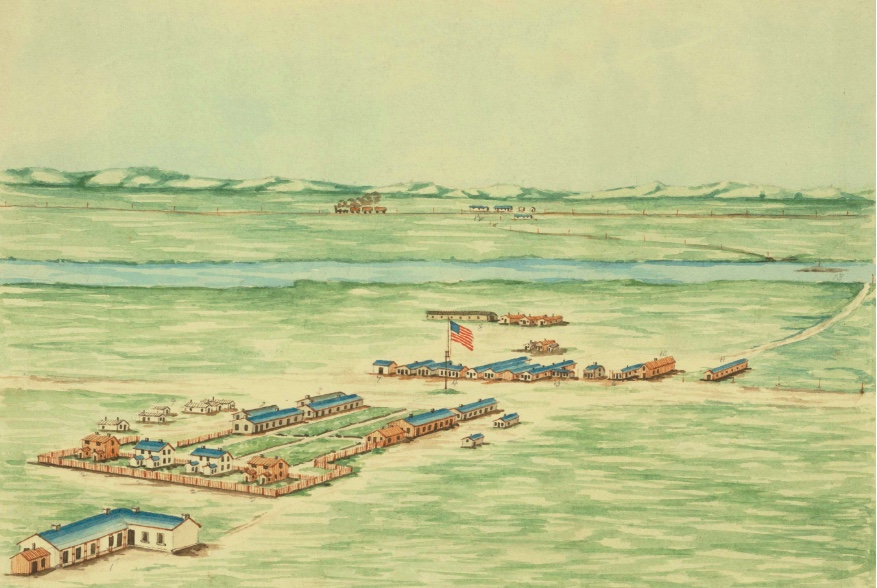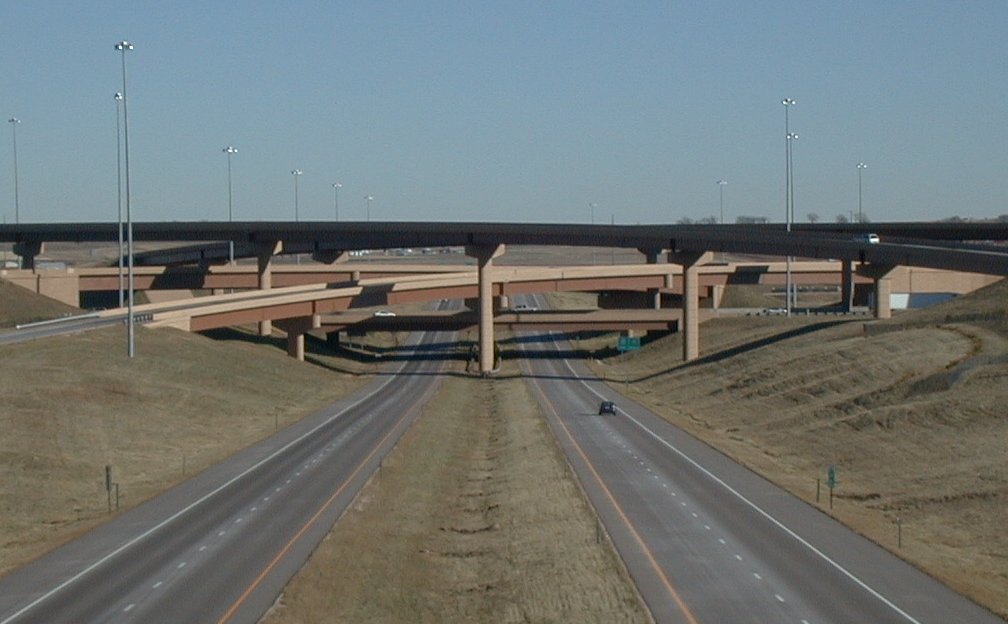|
South Platte River Trail Scenic And Historic Byway
The South Platte River Trail Scenic and Historic Byway is a Colorado Scenic and Historic Byway located in Sedgwick County, Colorado, USA. The byway follows the historic trails used during westward expansion. The route, which includes County Road 28 (CR 28) and U.S. Highway 138 (US 138), connects Ovid and Julesburg and encircles the South Platte River. It was designated a Colorado Scenic and Historic Byway in 1991. Route There is a trailhead for the byway at the Colorado Welcome Center at Julesburg. Informative placards are found throughout the route to provide additional insight into the area's storied history. Area historic sites, three of which are on the route, include the 19th century Fort Sedgwick, the state's only Pony Express home station, Telegraph Line, and Transcontinental railroad. Other historic sites include the Italian Caves, Devil's Dive, Upper California Crossing, a former Prisoner-of-war camp in Ovid, and the Julesburg Drag Racing Strip. ... [...More Info...] [...Related Items...] OR: [Wikipedia] [Google] [Baidu] |
Colorado Department Of Transportation
The Colorado Department of Transportation (CDOT, pronounced See Dot) is the principal department of the Colorado state government that administers state government transportation responsibilities in the state of Colorado. CDOT is responsible for maintaining 9,144 mile highway system, including 3,429 bridges with over 28 billion vehicle miles of travel per year. CDOT's Mission is "To provide the best multi-modal transportation system for Colorado that most effectively moves people, goods, and information." It is governed by the Transportation Commission of Colorado. Motor Carriers over 10,000 lbs are regulated by the state and are required to obtain a federal United States Department of Transportation (USDOT) safety tracking number used to monitor carriers' safety management practices and controls. History :''Source: CDOT'' The Colorado Department of Transportation has its roots in 1909, when the first highway bill was passed by forming a three-member Highway Commission to appr ... [...More Info...] [...Related Items...] OR: [Wikipedia] [Google] [Baidu] |
Pony Express
The Pony Express was an American express mail service that used relays of horse-mounted riders. It operated from April 3, 1860, to October 26, 1861, between Missouri and California. It was operated by the Central Overland California and Pikes Peak Express Company. During its 18 months of operation, the Pony Express reduced the time for messages to travel between the east and west US coast to about 10 days. It became the west's most direct means of eastwest communication before the first transcontinental telegraph was established (October 24, 1861), and was vital for tying the new U.S. state of California with the rest of the United States. Despite a heavy subsidy, the Pony Express was not a financial success and went bankrupt in 18 months, when a faster telegraph service was established. Nevertheless, it demonstrated that a unified transcontinental system of communications could be established and operated year-round. When replaced by the telegraph, the Pony Express quick ... [...More Info...] [...Related Items...] OR: [Wikipedia] [Google] [Baidu] |
Tourist Attractions In Sedgwick County, Colorado
Tourism is travel for pleasure or business; also the theory and practice of touring, the business of attracting, accommodating, and entertaining tourists, and the business of operating tours. The World Tourism Organization defines tourism more generally, in terms which go "beyond the common perception of tourism as being limited to holiday activity only", as people "travelling to and staying in places outside their usual environment for not more than one consecutive year for leisure and not less than 24 hours, business and other purposes". Tourism can be domestic (within the traveller's own country) or international, and international tourism has both incoming and outgoing implications on a country's balance of payments. Tourism numbers declined as a result of a strong economic slowdown (the late-2000s recession) between the second half of 2008 and the end of 2009, and in consequence of the outbreak of the 2009 H1N1 influenza virus, but slowly recovered until the COVID-19 pa ... [...More Info...] [...Related Items...] OR: [Wikipedia] [Google] [Baidu] |
Tourist Attractions In Colorado
Tourism is travel for pleasure or business; also the theory and practice of touring, the business of attracting, accommodating, and entertaining tourists, and the business of operating tours. The World Tourism Organization defines tourism more generally, in terms which go "beyond the common perception of tourism as being limited to holiday activity only", as people "travelling to and staying in places outside their usual environment for not more than one consecutive year for leisure and not less than 24 hours, business and other purposes". Tourism can be domestic (within the traveller's own country) or international, and international tourism has both incoming and outgoing implications on a country's balance of payments. Tourism numbers declined as a result of a strong economic slowdown (the late-2000s recession) between the second half of 2008 and the end of 2009, and in consequence of the outbreak of the 2009 H1N1 influenza virus, but slowly recovered until the COVID-19 pa ... [...More Info...] [...Related Items...] OR: [Wikipedia] [Google] [Baidu] |
Transportation In Sedgwick County, Colorado
Transport (in British English), or transportation (in American English), is the intentional movement of humans, animals, and goods from one location to another. Modes of transport include air, land (rail and road), water, cable, pipeline, and space. The field can be divided into infrastructure, vehicles, and operations. Transport enables human trade, which is essential for the development of civilizations. Transport infrastructure consists of both fixed installations, including roads, railways, airways, waterways, canals, and pipelines, and terminals such as airports, railway stations, bus stations, warehouses, trucking terminals, refueling depots (including fueling docks and fuel stations), and seaports. Terminals may be used both for interchange of passengers and cargo and for maintenance. Means of transport are any of the different kinds of transport facilities used to carry people or cargo. They may include vehicles, riding animals, and pack animals. Vehicles may inclu ... [...More Info...] [...Related Items...] OR: [Wikipedia] [Google] [Baidu] |
Transportation In Colorado
Colorado's transportation consists of a network of highway, surface street, rail, and air options. While the public transportation system in Denver is much more complex and developed than other parts of the state, tourism and growth have led to extensive needs statewide. Roads and highways Overview Colorado is a landlocked state, so ground and air transportation are the primary focus of the state. Also, due to low population density outside the Denver and Colorado Springs metropolitan areas, highways are the primary transportation method for most residents. Interstate and U.S. Highways The main north–south route in Colorado is Interstate 25 (I-25). The I-25 corridor follows the front range of the Colorado Rockies and connects Denver, Colorado Springs, Pueblo, Fort Collins, Greeley, Trinidad, and other small cities. I-70 crosses Colorado from west to east and is a primary viaduct for tourists and locals to visit mountain communities. When it was completed, the section of I ... [...More Info...] [...Related Items...] OR: [Wikipedia] [Google] [Baidu] |
Colorado Scenic And Historic Byways
Colorado Scenic and Historic Byways are highway and backroad routes in the U.S. state of Colorado designated by the Colorado Scenic and Historic Byways Commission for their scenic and historic values. These byways follow existing roads or highways and are signed with a Colorado blue columbine (the Colorado state flower) logo denoting the route. The Colorado Scenic and Historic Byways Program was established in March 1989, and is one of the oldest state scenic byway programs. Since 1989, the program has designated 26 Colorado Scenic and Historic Byways with of roadway, including scenic byway extensions in adjacent states. In addition to state scenic byway designations, four federal agencies designate specific types of scenic byways: #The Federal Highway Administration designates and (the highest designation.) #The National Park Service administers congressionally authorized #The United States Forest Service designates and manages in National Forests and National Grassland ... [...More Info...] [...Related Items...] OR: [Wikipedia] [Google] [Baidu] |
History Colorado
History Colorado is a historical society that was established in 1879 as the State Historical Society of Colorado, also known as the Colorado Historical Society. History Colorado is a 501(c)(3) organization and an agency of the State of Colorado under the Department of Higher Education. Overview History Colorado offers the public access to cultural and heritage resources of Colorado, including museums and special programs for individuals and families, collection stewardship of Colorado's historic treasures, educational resources for schools, students and teachers, services related to preservation, archaeology and history, and the Stephen H. Hart Research Library. History Colorado's statewide activities support tourism, historic preservation, education, and research related to Colorado's rich western history, offering the public unique opportunities to interact with Colorado history through its network of museums, which offer both exhibitions and special programs for adults and ch ... [...More Info...] [...Related Items...] OR: [Wikipedia] [Google] [Baidu] |
Prisoner-of-war Camp
A prisoner-of-war camp (often abbreviated as POW camp) is a site for the containment of enemy fighters captured by a belligerent power in time of war. There are significant differences among POW camps, internment camps, and military prisons. Purpose-built prisoner-of-war camps appeared at Norman Cross in England in 1797 during the French Revolutionary Wars and HM Prison Dartmoor, constructed during the Napoleonic Wars, and they have been in use in all the main conflicts of the last 200 years. The main camps are used for marines, sailors, soldiers, and more recently, airmen of an enemy power who have been captured by a belligerent power during or immediately after an armed conflict. Civilians, such as Merchant navy, merchant mariners and war correspondents, have also been imprisoned in some conflicts. With the adoption of the Geneva Convention on Prisoners of War (1929), Geneva Convention on the Prisoners of War in 1929, later superseded by the Third Geneva Convention, prisoner-o ... [...More Info...] [...Related Items...] OR: [Wikipedia] [Google] [Baidu] |
Transcontinental Railroad
A transcontinental railroad or transcontinental railway is contiguous railroad trackage, that crosses a continental land mass and has terminals at different oceans or continental borders. Such networks can be via the tracks of either a single railroad or over those owned or controlled by multiple railway companies along a continuous route. Although Europe is crisscrossed by railways, the railroads within Europe are usually not considered transcontinental, with the possible exception of the historic Orient Express. Transcontinental railroads helped open up unpopulated interior regions of continents to exploration and settlement that would not otherwise have been feasible. In many cases they also formed the backbones of cross-country passenger and freight transportation networks. Many of them continue to have an important role in freight transportation and some like the Trans-Siberian Railway even have passenger trains going from one end to the other. North America United States ... [...More Info...] [...Related Items...] OR: [Wikipedia] [Google] [Baidu] |
Fort Sedgwick
Fort Sedgwick, also known as Post at Julesburg, Camp Rankin, and Fort Rankin was a U.S. military post from 1864 to 1871, in Sedgwick County, Colorado. There are two historical markers for the former post. The town was named for Fort Sedgwick, which was named after John Sedgwick, who was a major general in the Union Army during the American Civil War. History In 1864, there was an increase in skirmishes with Native Americans from the Plains. As a result, in 1864 Camp Rankin was established near Julesburg with a couple of sod huts. It was renamed for an American Civil War hero, Major General John Sedgwick. It grew to a full-blown military installation. By 1866, it had three sets of company quarters, stables, and a corral. The U.S. militia guarded the Overland Stage Route (South Platte Trail), stage stations, and the telegraph line. Fort Sedgwick was one mile west of Julesburg, south of the South Platte River. The site is now southwest of the present Julesburg location. Fort Sedg ... [...More Info...] [...Related Items...] OR: [Wikipedia] [Google] [Baidu] |
Julesburg, Colorado
Julesburg is the statutory town that is the county seat and the most populous municipality of Sedgwick County, Colorado, United States. The population was 1,225 at the 2010 United States Census. It is close to the Nebraska border. History The original trading post was named for Jules Beni. Julesburg was on the Pony Express (1860–1861) route from Missouri to California. Jack Slade In 1858, Joseph A. "Jack" Slade, a superintendent for the Central Overland California and Pikes Peak Express Company, was tracking down horse thieves, including Jules Beni. Slade caught up with him at Julesburg, but Beni shot him five times. Everybody thought that Slade was dead and several angry townsfolk chased Beni out of Julesburg. When they returned, they found Slade struggling to his feet, having miraculously recovered. Beni continued to steal horses from the Pike's Peak Express Company, and Slade vowed to hunt him down. Beni attempted to ambush Slade at Slade's own ranch at Cold Spring ... [...More Info...] [...Related Items...] OR: [Wikipedia] [Google] [Baidu] |







